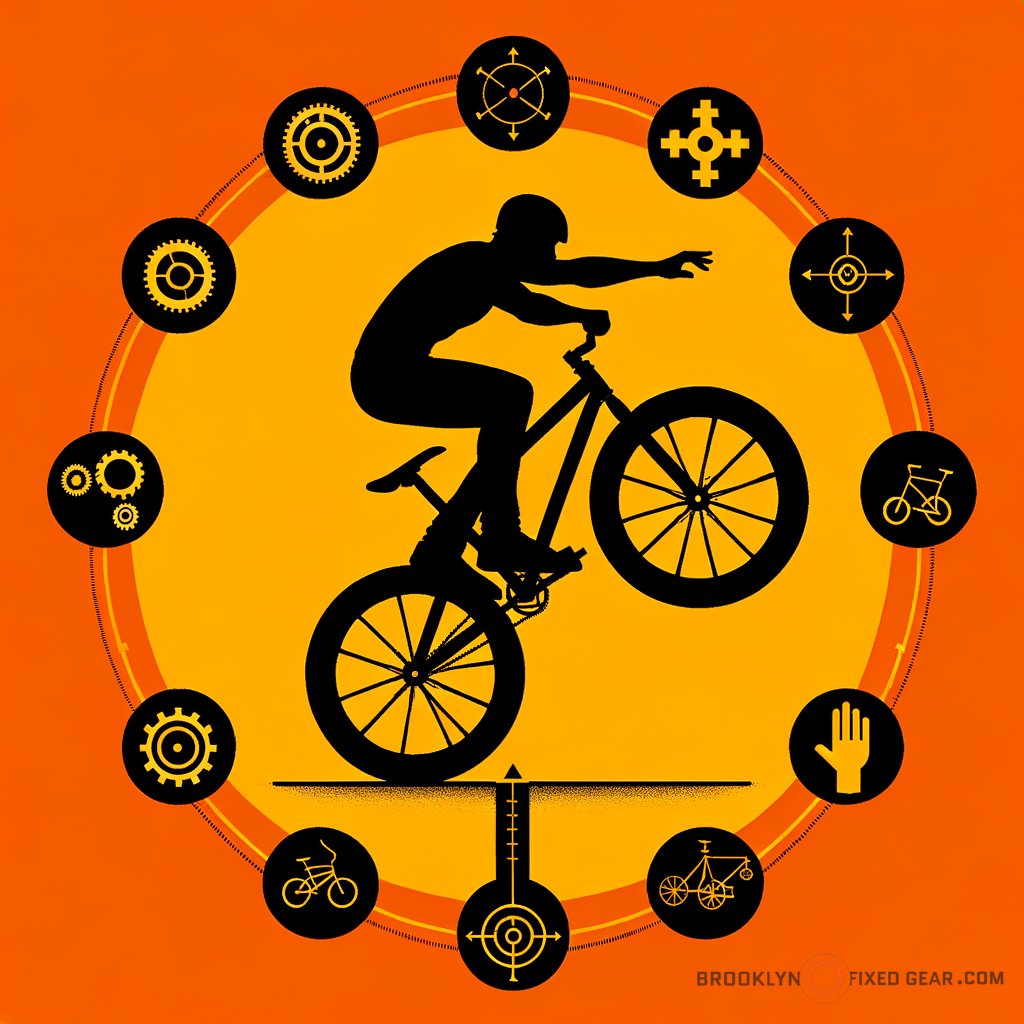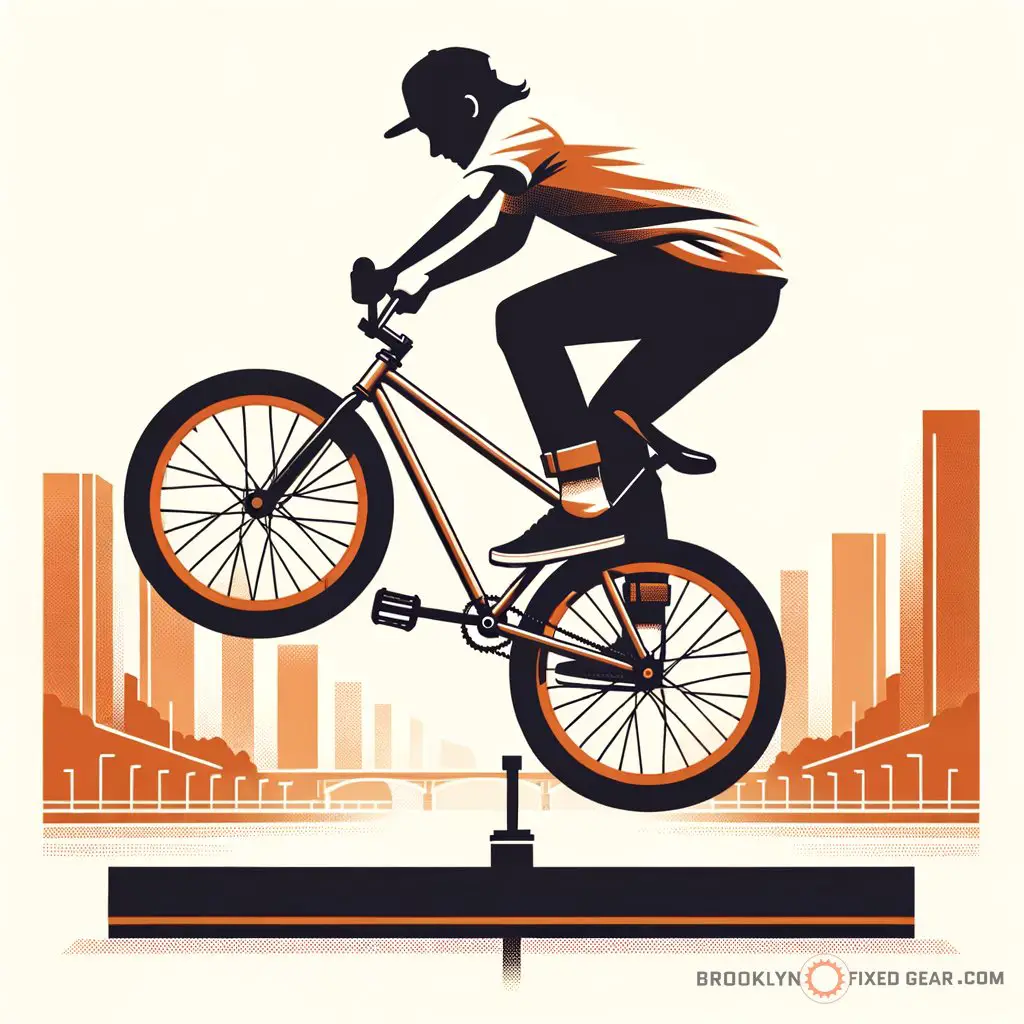Ever wondered what fixed-gear freestyle (FGFS) is all about? Curious about how riding a bike can turn into a mix of balance, tricks, and sheer urban creativity? What exactly is fixed-gear freestyle? In this post, you’ll dive into the world of FGFS and discover the essentials of this thrilling cycling discipline.
You might even find yourself itching to try some of these moves with one of the best fixie bikes around!
Key takeaways
- Fixed-gear freestyle is a blend of BMX and track cycling requiring skill and control.
- Choosing the right bike and components is crucial for performance and safety.
- The FGFS community is about connecting with other riders and urban expression.
Fixed-gear freestyle explained
Fixed-gear freestyle, or FGFS for short, is the art and sport of performing stunts and tricks on a fixed-gear bicycle. It combines elements of street BMX and track cycling, requiring a unique blend of skill, strength, and finesse. FGFS riders use their fixies to execute tricks like wheelies, barspins, and grinds, usually in urban environments.

The fixed-gear setup, with its lack of freewheel, means that pedaling is a constant and riders must use their momentum and bike control to navigate obstacles and land tricks.
Here’s a breakdown of what makes FGFS stand out:
- Direct control: Since the cranks are always moving, riders have a direct feel for the bike’s motion.
- Balance and precision: Tricks usually require precise control and balance, given the fixed nature of the gearing.
- Unique bikes: FGFS bikes are built tougher with reinforced frames, stronger wheels, and specific handlebars for control during tricks. Learn about selecting the right components with the guide to the best fixie bike handlebars.
This is no simple feat—riding FGFS means you’re both the engine and the brakes. Riders develop a deep sense of how to manipulate their bikes, as slowing down means resisting the pedal motion with their legs.
I’ve got to say, as someone who’s far from an expert on FGFS, this whole concept is wild. Imagine dancing with your bike, the streets becoming your stage as you twirl and hop from one spot to another—it’s a performance where precision meets reckless abandon. Riders say it’s something you feel in your bones, a kind of rhythm that comes alive when they hit the pavement.
Remember that scene from the film “Premium Rush” where the protagonist, a fixed-gear rider, nails tight moves through busy NYC streets? That’s the essence of FGFS—although stylized for the big screen, it captures the heart-pumping agility these riders possess. And even though I haven’t personally taken the leap into freestyle, stories of riders fearlessly flipping through cityscapes always have me in awe.
For those looking for a bit of inspiration or help in getting started, there’s always some useful info to be found on topics like what is a freewheel to sharpen your knowledge.
State Bicycle Co. Black Label 6061

State Bicycle Co. Black Label 6061
Core principles of fixed-gear freestyle
Fixed-gear freestyle is more than cycling; it’s an urban art form. Born from the fusion of freestyle BMX and track cycling, FGFS takes over where conventional riding stops. At its core are a few fundamental principles:
Simplicity and creativity
Riders thrive on the simplicity of a single gear and the creativity it sparks. No gears to shift or brakes to grab—just rider and bike in pure synchrony. With FGFS, a minimal setup leads to a world of innovative tricks and stunts.

Bike control and technique
The fixed gear mechanism forces a rider to master complete control over the bike. Controlling speed, executing tricks, and landing smoothly are all down to the rider’s technique, making FGFS a skilled practice.
Physical and mental challenge
Fixed-gear freestyle isn’t just physically demanding—it’s a mental game too. Riders must plot courses, imagine tricks, and push past fears. It’s about continually challenging oneself to nail that next big move.
Gear essentials and setup
Diving into fixed-gear freestyle starts with the right bike. Each component plays a part in the bike’s performance and the rider’s comfort level.
Choosing the right frame and components
The frame is the backbone of an FGFS bike. You need something sturdy yet agile. Components like the best bike multi-tools are vital for keeping your rig in top shape, ensuring each session is as good as the last.
Handlebars and foot retention
Selecting handlebars is crucial for control and comfort. Equally important is foot retention—straps or clips that keep you attached to the pedals during all the jumping and jostling. Without proper gear, you’re setting yourself up for a spill.
Saddles and ergonomics
FGFS can be tough on the body, making the choice of a saddle more than just aesthetics. Comfort and positioning are key, especially when pulling off extended sessions. That’s why understanding the importance of ergonomics in cycling can make a big difference.
Freestyle moves and tricks
Once you’ve got the gear, it’s time to hit the streets. FGFS involves a variety of moves, each with its own flair and difficulty level.
Basics: Wheelies and skids
Every newbie’s rite of passage includes mastering the wheelie and the skid. They lay the groundwork for balance and control as you advance to more complex maneuvers.
Intermediate: Barspins and tailwhips
Getting confident? Level up with barspins and tailwhips. These tricks demand timing and coordination but look spectacular when done right.
Advanced: Grinds and stalls
For the seasoned riders, grinding ledges and stalling on rails showcase a high level of skill. They’re not easy and come with a risk of falls, so gear up and practice diligently.
FGFS culture and community
Fixed-gear freestyle is more than just individual riders; it’s a community that’s as vibrant and diverse as the cities they ride in.
The role of urban environments
Cities offer a playground of obstacles and features for FGFS riders. Stairs, rails, and ledges become part of the sprawling canvas where riders express themselves.
Community events and competitions
From local meet-ups to global competitions, FGFS events are where riders share tricks, forge friendships, and push the sport forward.
Building local scenes and global connections
Whether you’re in New York or Tokyo, FGFS communities thrive on local scenes that connect globally, creating a network of support and inspiration for all levels of riders.
Fixed-gear freestyle is an evolving genre of cycling, as dynamic as the riders who love it. To jump in and join the movement, start with the basics, gear up, and connect with the local scene. There’s a world of freedom and creativity waiting on two wheels.
Discover it with FGFS.
In fixed-gear freestyle, understanding the specs and features of the gear can help navigate the sport. Below you’ll find a data table highlighting crucial elements of FGFS bikes and components that are worth considering.
| Bike Part | Role in FGFS | Considerations |
|---|---|---|
| Frame | Bike’s structure | Sturdiness, weight |
| Handlebars | Steering and tricks | Shape, width, durability |
| Pedals | Power and trick support | Grip, strength |
| Tires | Surface contact | Tread, width, pressure |
| Foot retention system | Securing feet to pedals | Ease of use, reliability |
“Imagine dancing with your bike, the streets becoming your stage as you twirl and hop from one spot to another—it’s a performance where precision meets reckless abandon. FGFS is more than cycling; it’s an urban art form that demands mastery, control, and a touch of daring.”
When diving into the world of fixed-gear freestyle, there’s a delicate balance to master—the “dos” that will accelerate your progress and elevate your experience, and the “don’ts” that could hinder your performance or, worse, lead to injury. Here’s a handy guide to keep you on the right track while you set the streets ablaze with your tricks.
| Do | Don’t |
|---|---|
| Start with basic tricks | Rush into advanced maneuvers too quickly |
| Always wear protective gear | Neglect bike maintenance |
| Practice in a safe, open area | Ignore local laws and regulations |
| Seek advice from experienced riders | Underestimate the importance of bike fit |
| Gradually build up your skillset | Perform tricks beyond your comfort level |

More fixed-gear freestyle tips
Whether you’re new to the fixie scene or looking to polish your freestyle chops, here are some extra pointers to keep you rolling smoothly and safely:
- Check your bike before every ride to ensure everything’s tight and right—from your handlebars to your chain tension.
- Invest in a high-quality helmet and other safety gear; it can make all the difference when trying out new stunts.
- Familiarize yourself with foot retention systems for better control during tricks. Proper foot retention in cycling is a game changer.
- Watch videos of seasoned FGFS riders to understand the flow and form of different tricks.
- Stay patient and persistent. Progress in FGFS can be slow, and that’s okay. It’s all about the journey.
- Join a local FGFS group or online community for motivation, tips, and friendship.
- Keep an open mind and have fun. After all, FGFS is as much about creativity and expression as it is about athleticism.
If you are a visual learner, check out this video titled ‘Fixed gear freestyle and injuring my foot’
Frequently asked questions (FAQ)
Can fixed-gear bikes be used for everyday commuting?
Absolutely, fixed-gear bikes, known affectionately as ‘fixies,’ are great for urban commuting. Their simplicity means less maintenance, and many riders enjoy the control and connection to the bike that a fixed-gear provides. Just be sure to familiarize yourself with how to handle the bike in traffic and perhaps opt for a model with a front brake if you’re a commuter for extra safety.
What kind of maintenance do FGFS bikes require?
FGFS bikes require regular maintenance to keep them in tip-top shape, especially considering the wear and tear from tricks. This includes checking the chain tension, ensuring bolts are tight, and wheels are true. Also, inspect your bike for any cracks or damage, especially after a fall or a session of intense tricks, to avoid mishaps on your next ride.
Are there professional FGFS riders?
Yes, there are professional riders who have taken FGFS to new heights, competing in events and showcasing their skills in videos. These pros usually push the boundaries of what’s possible on a fixie, and they serve as inspirations and role models to burgeoning riders internationally. Their sponsorship deals and social media presence help promote the sport and community around the world.
Final thoughts
As you reach the end of this journey through the thrilling world of fixed-gear freestyle, remember that FGFS is more than just a sport—it’s a vibrant community and a form of expression on two wheels. It’s a commitment to balance, creativity, and urban exploration that reflects the rider’s personality just as much as their skills. Whether you’re just starting out or looking to level up your game, embrace the constant learning process and enjoy every moment on your fixie.
Have you tried any FGFS tricks or are you planning to dive into this dynamic cycling discipline? Did I cover everything you wanted to know? Let me know in the comments section belowI read and reply to every comment. If you found this article helpful, share it with a friend, and check out my full blog for more tips and tricks on fixed-gear freestyle cycling. Thanks for reading and keep spinning those pedals!















